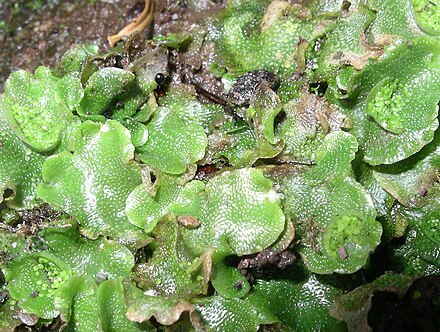Marchantiophyta
The Marchantiophyta (/mɑːrˌkæntiˈɒfətə, -oʊˈfaɪtə/ (listen)![]() ) are a division of non-vascular land plants commonly referred to as hepatics or liverworts. Like mosses and hornworts, they have a gametophyte-dominant life cycle, in which cells of the plant carry only a single set of genetic information.
) are a division of non-vascular land plants commonly referred to as hepatics or liverworts. Like mosses and hornworts, they have a gametophyte-dominant life cycle, in which cells of the plant carry only a single set of genetic information.
It is estimated that there are about 9000 species of liverworts.[4] Some of the more familiar species grow as a flattened leafless thallus, but most species are leafy with a form very much like a flattened moss. Leafy species can be distinguished from the apparently similar mosses on the basis of a number of features, including their single-celled rhizoids. Leafy liverworts also differ from most (but not all) mosses in that their leaves never have a costa (present in many mosses) and may bear marginal cilia (very rare in mosses). Other differences are not universal for all mosses and liverworts, but the occurrence of leaves arranged in three ranks, the presence of deep lobes or segmented leaves, or a lack of clearly differentiated stem and leaves all point to the plant being a liverwort. Liverworts are distinguished from mosses in having unique complex oil bodies of high refractive index.
Liverworts are typically small, usually from 2–20 mm wide with individual plants less than 10 cm long, and are therefore often overlooked. However, certain species may cover large patches of ground, rocks, trees or any other reasonably firm substrate on which they occur. They are distributed globally in almost every available habitat, most often in humid locations although there are desert and Arctic species as well. Some species can be a nuisance in shady greenhouses or a weed in gardens.[5]
Most liverworts are small, measuring from 2–20 millimetres (0.08–0.8 in) wide with individual plants less than 10 centimetres (4 in) long,[6] so they are often overlooked. The most familiar liverworts consist of a prostrate, flattened, ribbon-like or branching structure called a thallus (plant body); these liverworts are termed thallose liverworts. However, most liverworts produce flattened stems with overlapping scales or leaves in two or more ranks, the middle rank is often conspicuously different from the outer ranks; these are called leafy liverworts or scale liverworts.[7][8] (See the gallery below for examples.)
Liverworts can most reliably be distinguished from the apparently similar mosses by their single-celled rhizoids.[9] Other differences are not universal for all mosses and all liverworts;[8] but the lack of clearly differentiated stem and leaves in thallose species, or in leafy species the presence of deeply lobed or segmented leaves and the presence of leaves arranged in three ranks,[10][11] as well as frequent dichotomous branching, all point to the plant being a liverwort. Unlike any other embryophytes, most liverworts contain unique membrane-bound oil bodies containing isoprenoids in at least some of their cells, lipid droplets in the cytoplasm of all other plants being unenclosed.[12] The overall physical similarity of some mosses and leafy liverworts means that confirmation of the identification of some groups can be performed with certainty only with the aid of microscopy or an experienced bryologist.

